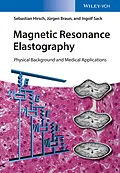Magnetic resonance elastography (MRE) is a medical imaging technique that combines magnetic resonance imaging (MRI) with mechanical vibrations to generate maps of viscoelastic properties of biological tissue. It serves as a non-invasive tool to detect and quantify mechanical changes in tissue structure, which can be symptoms or causes of various diseases. Clinical and research applications of MRE include staging of liver fibrosis, assessment of tumor stiffness and investigation of neurodegenerative diseases.
The first part of this book is dedicated to the physical and technological principles underlying MRE, with an introduction to MRI physics, viscoelasticity theory and classical waves, as well as vibration generation, image acquisition and viscoelastic parameter reconstruction.
The second part of the book focuses on clinical applications of MRE to various organs. Each section starts with a discussion of the specific properties of the organ, followed by an extensive overview of clinical and preclinical studies that have been performed, tabulating reference values from published literature. The book is completed by a chapter discussing technical aspects of elastography methods based on ultrasound.
Autorentext
Ingolf Sack is professor for Experimental Radiology and Elastography at Charite - Universitatsmedizin Berlin, Germany. He received a PhD in Chemistry at Freie Universitat Berlin, Germany, for the development of methods in NMR spectroscopy. He worked at the Weizmann Institute in Rehovot, Israel, and at the Sunnybrook Hospital Toronto, Canada. Since 2003 he leads an interdisciplinary team of physicists, engineers, chemists and physicians which has pioneered pivotal developments in time-harmonic elastography of both MRI and ultrasound for many medical applications.
Sebastian Hirsch is a postdoctoral fellow in the Department of Radiology at the Charite - Universitatsmedizin Berlin, Germany. After studying physics at the University of Mainz, Germany, he joined Charite, where he works on pressure-sensitive MRE and the development of data acquisition strategies.
Jurgen Braun is an assistant professor at the Charite - Universitatsmedizin Berlin, Germany. He received his PhD degree in physical chemistry from Albert-Ludwigs-University in Freiburg, Germany, for the elucidation of reaction kinetics with liquid and solid state NMR. He possesses long standing professional experience in elastography, medical engineering, and image processing.
Inhalt
About the Authors xiii
Foreword xv
Preface xvii
Acknowledgments xix
Notation xxi
List of Symbols xxiii
Introduction 1
Part I Magnetic Resonance Imaging 7
1 Nuclear Magnetic Resonance 9
1.1 Protons in a Magnetic Field 9
1.2 Precession of Magnetization 10
1.2.1 Quadrature Detection 11
1.3 Relaxation 13
1.4 Bloch Equations 14
1.5 Echoes 15
1.5.1 Spin Echoes 15
1.5.2 Gradient Echoes 17
1.6 Magnetic Resonance Imaging 17
1.6.1 Spatial Encoding 18
1.6.1.1 Slice Selection 19
1.6.1.2 Phase Encoding 19
1.6.1.3 Frequency Encoding 20
2 Imaging Concepts 23
2.1 k-Space 23
2.2 k-Space Sampling Strategies 26
2.2.1 Segmented Image Acquisition 27
2.2.1.1 Fast Low-Angle Shot (FLASH) 27
2.2.1.2 Balanced Steady-State Free Precession (bSSFP) 28
2.2.2 Echo-Planar Imaging (EPI) 30
2.2.3 Non-Cartesian Imaging 32
2.3 Fast Imaging 33
2.3.1 Fast Imaging Strategies 33
2.3.2 Partial Fourier Imaging 34
2.3.3 Parallel Imaging 35
2.3.3.1 Grappa 36
2.3.4 Impact of Fast Imaging on SNR and Scan Time 37
3 Motion Encoding and MRE Sequences 41
3.1 Motion Encoding 43
3.1.1 Gradient Moment Nulling 44
3.1.2 Encoding of Time-Harmonic Motion 46
3.1.3 Fractional Encoding 50
3.2 Intra-Voxel Phase Dispersion 51
3.3 Diffusion-Weighted MRE 52
3.4 MRE Sequences 53
3.4.1 Flash-mre 53
3.4.2 bSSFP-MRE 55
3.4.3 Epi-mre 57
Part II Elasticity 61
4 Viscoelastic Theory 63
4.1 Strain 63
4.2 Stress 67
4.3 Invariants 68
4.4 Hooke's Law 69
4.5 Strain-Energy Function 70
4.6 Symmetries 71
4.7 Engineering Constants 75
4.7.1 Young's Modulus and Poisson's Ratio 75
4.7.2 Shear Modulus and Lamé's First Parameter 76
4.7.3 Compressibility and Bulk Modulus 77
4.7.4 Compliance and Elasticity Tensor for a Transversely Isotropic Material 79
4.8 Viscoelastic Models 80
4.8.1 Elastic Model: Spring 81
4.8.2 Viscous Model: Dashpot 82
4.8.3 Combinations of Elastic and Viscous Elements 83
4.8.4 Overview of Viscoelastic Models 89
4.9 Dynamic Deformation 92
4.9.1 Balance of Momentum 92
4.9.2 Mechanical Waves 96
4.9.2.1 Complex Moduli and Wave Speed 98
4.9.3 NavierStokes Equation 99
4.9.4 Compression Modulus and Oscillating Volumetric Strain 100
4.9.5 Elastodynamic Green's Function 101
4.9.6 Boundary Conditions 103
4.10 Waves in Anisotropic Media 104
4.10.1 The Christoffel Equation 105
4.10.2 Waves in a Transversely Isotropic Medium 106
4.11 Energy Density and Flux 110
4.11.1 Geometric Attenuation 113
4.12 Shear Wave Scattering from Interfaces and Inclusions 114
4.12.1 Plane Interfaces 115
4.12.2 Spatial and Temporal Interfaces 118
4.12.3 Wave Diffusion 121
4.12.3.1 Green's Function of Waves and Diffusion Phenomena 125
4.12.3.2 Amplitudes and Intensities of Diffusive Waves 126
5 Poroelasticity 131
5.1 Navier's Equation for Biphasic Media 133
5.1.1 Pressure Waves in Poroelastic Media 136
5.1.2 Shear Waves in Poroelastic Media 140
5.2 Poroelastic Signal Equation 142
Part III Technical Aspects and Data Processing 145
6 MRE Hardware 147
6.1 MRI Systems 147
6.2 Actuators 153
6.2.1 Technical Requirements 153
6.2.2 Practicality 153
6.2.3 Types of ...
